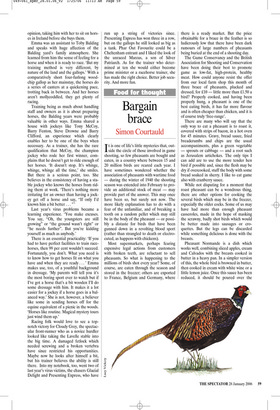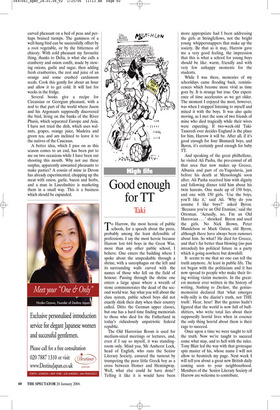Bargain brace
Simon Courtauld
It is one of life’s little mysteries that, outside the circle of those involved in game shooting, so few pheasants are bought and eaten, in a country where between 15 and 20 million birds are reared each year. I have sometimes wondered whether the association of pheasants with wartime food — during the winter of 1940 the shooting season was extended into February to provide an additional stock of meat — may provide part of the answer. This may once have been so, but surely not now. The more likely explanation has to do with a fear of the unfamiliar, and of breaking a tooth on a random pellet which may still be in the body of the pheasant — or possibly a distaste for birds that have been gunned down in a revolting blood sport (rather than strangled to death or electrocuted, as happens with chickens).
Most supermarkets, perhaps fearing expensive legal actions from customers with broken teeth, are reluctant to sell pheasants. So what is happening to the millions of birds shot every year? Some, of course, are eaten through the season and stored in the freezer; others are exported to France, Belgium and Germany, where there is a ready market. But the price obtainable for a brace in the feather is so ludicrously low that there have been dark rumours of large numbers of pheasants being buried at the end of a shooting day.
The Game Conservancy and the British Association for Shooting and Conservation have been doing their best to promote game as low-fat, high-protein, healthy meat. How could anyone resist the offer from our local farm shop this month of three brace of pheasants, plucked and dressed, for £10 — little more than £1.50 a bird? Properly cooked, and having been properly hung, a pheasant is one of the best eating birds, it has far more flavour and is often cheaper than chicken, and it is of course truly ‘free-range’.
There are many who will say that the only way to eat a pheasant is to roast it, covered with strips of bacon, in a hot oven for 45 minutes. Gravy, bread sauce, fried breadcrumbs and chips are the usual accompaniments, plus a green vegetable — sprouts or cabbage — and a root such as Jerusalem artichokes. The only tips I can add are to use the more tender hen bird if possible and, since the flesh may be dry if overcooked, stuff the body with some bread soaked in sherry. I like to eat game also with cranberry sauce.
While not disputing for a moment that roast pheasant can be a wondrous thing, there are other options for cooking the several birds which may be in the freezer, especially the older cocks. Some of us may have had more than enough pheasant casseroles, made in the hope of masking the scrawny, badly shot birds which would be better made into sausages or croquettes. But the legs can be discarded while something delicious is done with the breasts.
Pheasant Normande is a dish which works well, combining sliced apples, cream and Calvados with the breasts cooked in butter in a heavy pan. In a simpler version of this, the whole bird is browned in butter, then cooked in cream with white wine or a little lemon juice. Once this sauce has been reduced, it should be poured over the carved pheasant on a bed of peas and perhaps braised turnips. The gaminess of a well-hung bird can be successfully offset by a root vegetable, or by the bitterness of chicory. With cold pheasant my favourite thing, thanks to Delia, is what she calls a cranberry and onion confit, made by stewing onions, garlic and sugar, then adding fresh cranberries, the zest and juice of an orange and some crushed cardamom seeds. Cook this gently for about an hour and allow it to get cold. It will last for weeks in the fridge.
Several books give a recipe for Circassian or Georgian pheasant, with a nod to that part of the world where Jason and his Argonauts supposedly discovered the bird, living on the banks of the River Phasis, which separated Europe and Asia. I have not tried the dish, which uses walnuts, grapes, orange juice, Madeira and green tea, and am inclined to leave it to the natives of the Caucasus.
A better idea, which I pass on as this season comes to an end, has been put to me on two occasions while I have been out shooting this month. Why not use these surplus, apparently unwanted pheasants to make pasties? A cousin of mine in Devon has already experimented, chopping up the meat with onion, garlic, bacon and herbs, and a man in Lincolnshire is marketing them in a small way. This is a business which should be expanded.























































 Previous page
Previous page